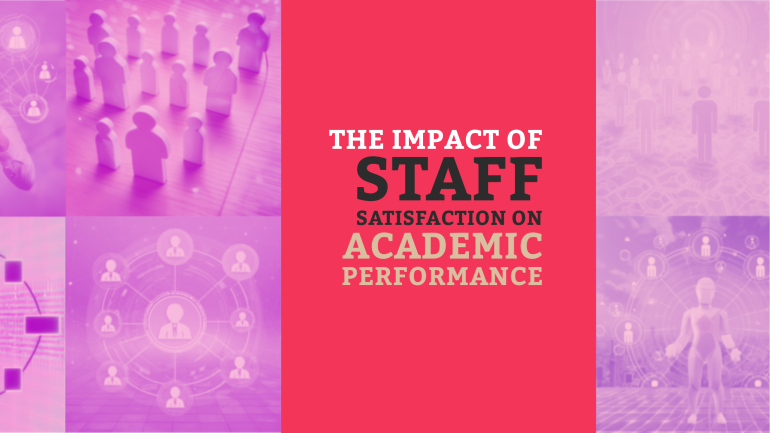Table of Contents
TL;DR: The Impact of Staff Satisfaction on Academic Performance
- Staff satisfaction plays a critical role in academic performance as content employees are likely to be more productive and engaged in their roles.
- Healthy working environment and positive relationships between staff can foster a sense of collaboration and teamwork, ultimately benefiting students.
- When staff members feel valued and supported by the institution, they are more likely to go the extra mile to enhance the learning experience for students.
- Reducing staff turnover by improving employee satisfaction can lead to stability and consistency in teaching quality and curriculum delivery.
- Investing in professional development opportunities, effective communication, and wellness programs can contribute to boosting staff satisfaction levels and in turn, improving academic outcomes.
With a workforce that is motivated and satisfied, academic institutions can expect to see a drastic improvement in their overall academic performance. Research has shown that the level of satisfaction among staff directly correlates with their productivity, commitment, and engagement in their roles, ultimately influencing student outcomes. Recognizing the significance of staff satisfaction in the academic setting can lead to increased retention rates, positive learning environments, and higher student achievement. In this post, we probe into the various ways in which staff satisfaction impacts academic performance and why it should be a top priority for educational institutions.
Theoretical Framework
Theories of Employee Motivation
It is widely recognized that motivation plays a crucial role in determining the level of employee satisfaction within an organization. Theories of employee motivation such as Maslow’s Hierarchy of Needs, Herzberg’s Two-Factor Theory, and Expectancy Theory provide insight into the factors that drive employee behavior and job performance.
The Relationship Between Satisfaction and Performance
For decades, researchers have been exploring the complex relationship between employee satisfaction and job performance. Numerous studies have shown a strong positive correlation between staff satisfaction and academic performance. Employees who feel valued, supported, and engaged are more likely to be productive and contribute positively to the overall performance of an organization.
Relationship: Understanding the intricate connection between staff satisfaction and academic performance is vital for educational institutions striving to enhance their effectiveness. By prioritizing employee well-being and creating a positive work environment, institutions can promote a culture of excellence and improve their academic outcomes.
Measuring Staff Satisfaction
There’s no doubt that staff satisfaction plays a crucial role in the overall performance of any academic institution. In order to measure staff satisfaction effectively, it is important to employ a combination of quantitative and qualitative methods.
Quantitative and Qualitative Methods
To get a comprehensive understanding of staff satisfaction, academic institutions can utilize both quantitative and qualitative methods. Quantitative data can be gathered through surveys and questionnaires, allowing for the measurement of specific metrics such as overall satisfaction levels and key areas of concern. On the other hand, qualitative methods like focus groups and interviews can provide in-depth insights into the underlying reasons behind staff satisfaction or dissatisfaction.
Indicators of Staff Satisfaction
Satisfaction indicators are crucial in evaluating the overall well-being of staff members within an academic institution. Important indicators of staff satisfaction may include factors such as workload balance, communication effectiveness, opportunities for professional development, recognition of achievements, and workplace culture. Monitoring and addressing these indicators can significantly impact staff morale and ultimately improve academic performance.
Impact on Academic Outcomes
Effects on Student Success
Once again, the correlation between staff satisfaction and academic outcomes is undeniable. With a content and engaged faculty and staff, the learning environment becomes more conducive to student success. Happy employees are more likely to go above and beyond to support and challenge their students, resulting in higher levels of achievement and retention.
Institutional Benefits of High Staff Satisfaction
To emphasize the significance of staff satisfaction on academic performance, one must also consider the institutional benefits that stem from a content workforce. High levels of staff satisfaction lead to lower employee turnover rates, reduced absenteeism, and increased productivity. Understanding and investing in staff satisfaction can ultimately lead to a more efficient and successful academic institution overall.
Strategies for Improving Staff Satisfaction
Professional Development Opportunities
On an organizational level, providing ongoing professional development opportunities is crucial for enhancing staff satisfaction. By investing in training programs, workshops, and conferences, employees feel valued and supported in their career growth. This not only helps in upskilling staff but also boosts morale and motivation.
Creating a Supportive Work Environment
Professionalism in creating a supportive work environment is key to improving staff satisfaction. Ensuring open communication channels, recognizing and celebrating achievements, and fostering a culture of teamwork all contribute to a positive work environment. When staff feel supported and respected, they are more likely to be engaged and productive.
The establishment of regular feedback mechanisms, mentorship programs, and wellness initiatives also play a significant role in creating a supportive work culture. Encouraging work-life balance and providing resources for mental health support demonstrate an organization’s commitment to the well-being of its staff.
To wrap up
Ultimately, staff satisfaction plays a crucial role in improving academic performance in educational institutions. A satisfied and motivated staff is more likely to be engaged, productive, and committed to the success of their students. By ensuring that staff members feel valued, supported, and respected, schools can foster a positive work environment that directly contributes to enhanced teaching effectiveness, student learning outcomes, and overall academic success. Investing in staff satisfaction is not only beneficial for the employees themselves but also leads to a more successful and thriving educational community as a whole.
FAQ
Q: What is the relationship between staff satisfaction and academic performance?
A: Staff satisfaction has a direct impact on academic performance. When staff members are satisfied with their work environment, they are more motivated and engaged, leading to higher productivity and better outcomes for students.
Q: How does staff satisfaction affect student achievement?
A: Research has shown that there is a strong correlation between staff satisfaction and student achievement. When teachers and support staff are happy and fulfilled in their roles, they are better able to provide quality education and support for students, leading to improved academic performance.
Q: What are the factors that contribute to staff satisfaction in an educational setting?
A: Factors that contribute to staff satisfaction in an educational setting include a positive work environment, opportunities for professional development, recognition of hard work, competitive salaries, work-life balance, and supportive leadership.
Q: How can educational institutions improve staff satisfaction levels?
A: Educational institutions can improve staff satisfaction levels by implementing policies and practices that promote a positive work culture, providing opportunities for training and career advancement, recognizing and rewarding staff performance, offering competitive salaries and benefits, and fostering open communication between staff and leadership.
Q: What are the benefits of investing in staff satisfaction for academic institutions?
A: Investing in staff satisfaction can lead to higher retention rates, increased productivity, improved student outcomes, enhanced reputation of the institution, and overall success in achieving educational goals. Happy and satisfied staff members are vital for creating a positive and successful learning environment.




